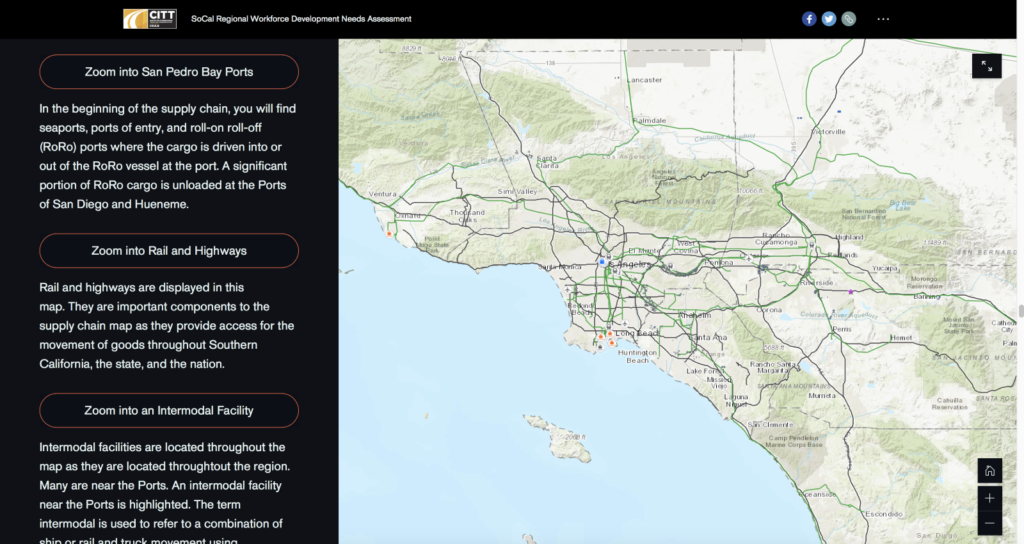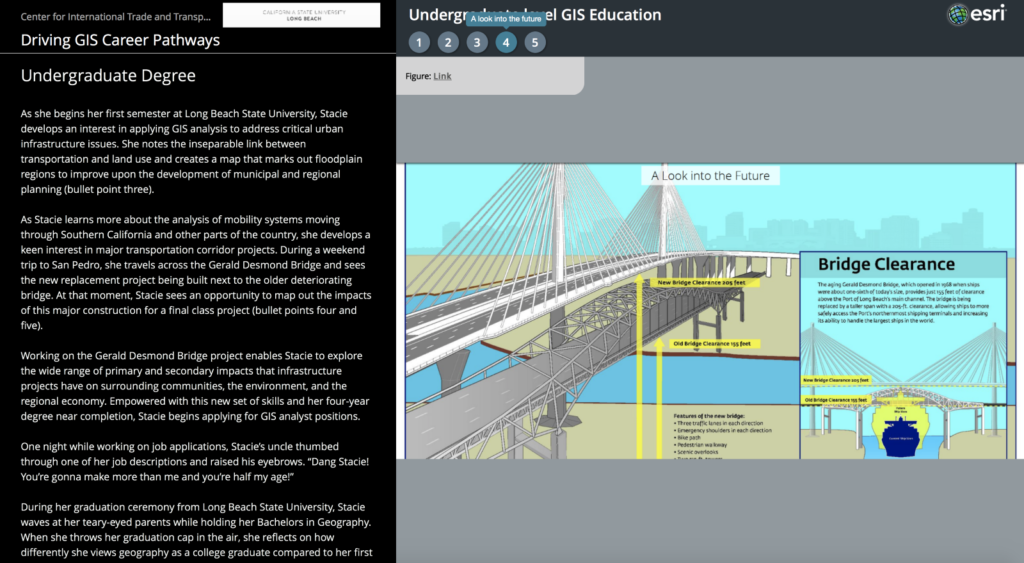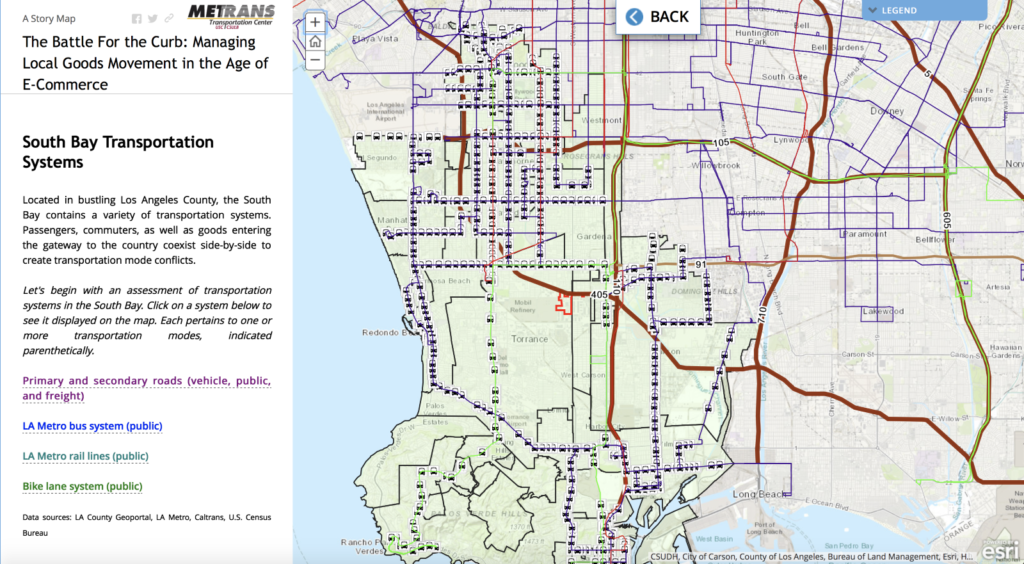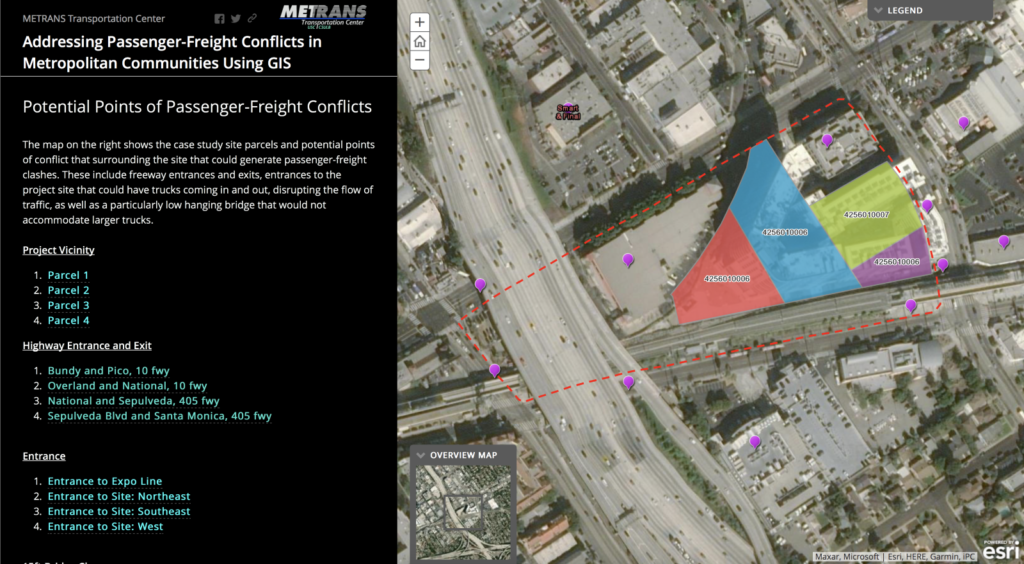Esri has created a digital storytelling tool known as a StoryMap. A StoryMap is a web-based application that allows users to create and build stories with customized maps. Users can contextualize their narrative in a StoryMap by embedding text, images, videos, and online content (e.g. web apps, social media posts, dashboards, and websites) to their map. The application provides templates for users to choose from and guides within the application, making the storytelling tool user-friendly. StoryMaps is part of the larger ArcGIS suite of web and desktop mapping and analysis tools. The app was designed with the integration of maps, data, and web applications created with those tools in mind. This allows embedded maps to be navigated and interacted with by users, enriching their experience.
StoryMaps are versatile in the ways they can be applied. CITT has incorporated StoryMaps into several of its projects and has found the tool to be helpful, in particular, as a training and presentation aid. Projects that have benefitted from the use of StoryMaps include: Workforce Training & Career Development, Supply Chain Infrastructure, and GIS in Transportation Planning. In Workforce Training & Career Development, CITT has applied StoryMaps as a curricular tool in order to demonstrate how data can connect to image and narrative to tell a story about a particular project. This is particularly valuable when communicating with diverse audiences. Teaching StoryMaps involves teaching GIS and how to communicate with it. Being web-based and integrated with other web-based GIS tools makes it more accessible and easier to distribute to students than desktop software. Participants in the 2020 Caltrans Freight Academy used StoryMaps to communicate the role of freight in their local regions, and CITT is developing a workshop for high schools that will use story maps to help students to explore, understand, and communicate sustainable transportation issues in their communities. In Supply Chain Infrastructure, CITT has used StoryMaps to share the results of research topics such as the impacts of COVID-19 on the supply chain. They are also useful as interactive maps to help visualize the supply chain throughout Southern California. For GIS in Transportation Planning, CITT has created StoryMaps that show how GIS is used as a tool in transportation planning and helps to reveal the unique characteristics of cities, communities, and individual blocks.
Thematic Forces
Workforce Training and Career Development
- Southern California Regional Workforce Development Needs Assessment for the Transportation and Supply Chain Industry Sectors presents promising practice recommendations for program content, design, and delivery with developments concerning the role of Institutes of Higher Education (IHEs) in workforce education for supply chain industry sectors.

- Visualizing Sustainable Transportation Choices for K-12 provides a discussion on the benefits of introducing spatial thinking in K-12 education. GIS allows students to become spatial thinkers by collecting, analyzing, and visualizing their data. Visualizing their impact would help students participating in the GIS activity to strengthen their sustainable thinking.
- Driving GIS Career Pathways provides a comprehensive summary of various steps necessary in choosing GIS as a career path. This demonstrates an individual’s journey from high school dual enrollment to obtaining an undergraduate degree and later joining the workforce.

- Top 25 Transportation Job Projections in the Southwest Transportation Workforce Center (SWTWC) Region highlights the top 25 job projections within each state in the SWTWC region and details critical occupations and related labor market data.
Supply Chain Infrastructure
- The Battle for the Curb: Managing Local Goods Movement in the Age of E-Commerce was used as an instructional tool in a pilot course for public and private professionals on the biggest goods movement challenges in the 21st century occurring in last-mile and last foot urban freight planning.

- Freight Corridor Planning and Improvement discusses designing and planning more efficient ways to reliably move freight in specific freeway segments with high truck volumes at a more granular level in California’s Inland Empire warehousing region, Ontario, California.
- Maintaining and Improving Freight Corridors Using GIS provides a discussion on designing and planning more efficient ways to reliably move freight in specific freeway segments with high truck volumes at a more granular level in California’s Central Valley agricultural region, Sacramento, California.
- Digital Freight Matching Technology and the Role of GIS demonstrate the potential benefits of DFM on the Trucking industry and the importance of GIS in alleviating inefficiency and congestion problems in society.
GIS in Transportation Planning
- The Role of GIS in Protecting Cultural Resources explores collecting volunteered geographic information with tools like Survey 123 for transportation efforts to incorporate in the protection and preservation of cultural resources.
- Assessing Los Angeles’ Complex Transportation Network emphasizes GIS and its importance in making well-informed decisions through the visualization of geospatial data, access of real-time transportation and survey data, and ability to perform comprehensive analyses on complex Los Angeles’s transportation datasets.
- Addressing Passenger-Freight Conflicts in Metropolitan Communities Using GIS helps transportation and regional planners make better informed decision by collecting and visualizing areas of conflict in metropolitan communities with geodata.

Suggested Categories:
1) Workforce Training & Career Development
2) Supply Chain Infrastructure
3) GIS in Transportation Planning
- Top 25 Transportation Job Projections in the Southwest Transportation Workforce Center (SWTWC) Region
- Visual resource displaying the top 25 transportation job projections in each of the eight states in the SWTWC region: Arizona, California, Colorado, Nevada, New Mexico, Oklahoma, Texas, and Utah
- Addressing Passenger-Freight Conflicts in Metropolitan Communities Using GIS
- Instructional tool for the 2017 METRANS Metropolitan Transportation Management Certificate Course
- Winner of the 2017 Southern California Association of Governments (SCAG) Student Story Map Competition
- Assessing Los Angeles’ Complex Transportation Network
- Instructional tool for the 2018 GIS pilot course at Los Angeles Trade Technical College (LATTC) as part of the National Transportation Career Pathway Initiative (NTCPI)
- Driving GIS Career Pathways
- Hypothetical narrative of a high school student who enters a GIS career pathway
- Finalist submission at the 2018 Southern California Association of Governments (SCAG) Student Story Map Competition
- Maintaining and Improving Freight Corridors Using GIS
- Instructional tool on the supply chain in California’s Central Valley agricultural region for the 2018 Caltrans Freight Academy in Sacramento, CA
- Freight Corridor Planning and Improvement
- Instructional tool on the supply chain in California’s Inland Empire warehousing region for the 2018 Caltrans Freight Academy in Ontario, CA
- The Battle for the Curb: Managing Local Goods Movement in the Age of E-Commerce
- Instructional tool for 2019 pilot course for public and private professionals on last-mile urban freight planning
- Digital Freight Matching Technology and the Role of GIS
- Visualization of digital freight matching as a solution to Southern California freight issues
- Winner of the 2019 Southern California Association of Governments (SCAG) Student Story Map Competition
- The Role of GIS in Protecting Cultural Resources
- Discussion of the role of GIS in sustainable transportation planning at protected architectural sites
- Finalist submission at the 2020 Southern California Association of Governments (SCAG) Student Story Map Competition
- Visualizing Sustainable Transportation Choices for K-12
- Instructional tool for K-12 audiences introducing GIS basics and sustainable transportation concepts
- Second place winner at the 2020 Southern California Association of Governments (SCAG) Student Story Map Competition
- Southern California Regional Workforce Development Needs Assessment for the Transportation and Supply Chain Industry Sectors
- Comprehensive summary and visualization of the Southern California regional supply chain
- Overview of the results of a 2020 needs assessment of the Los Angeles regional transportation and supply chain industry workforce issues